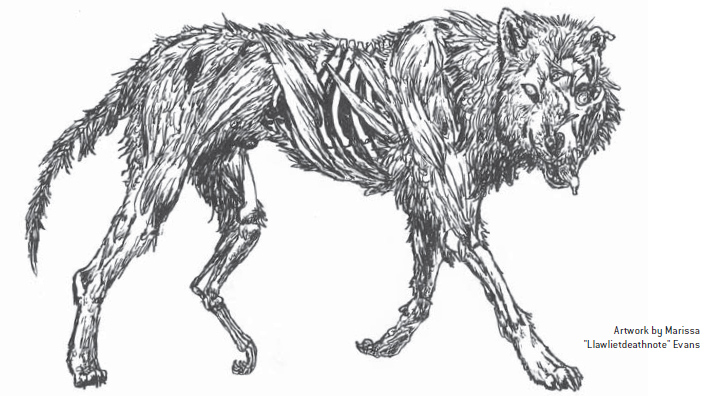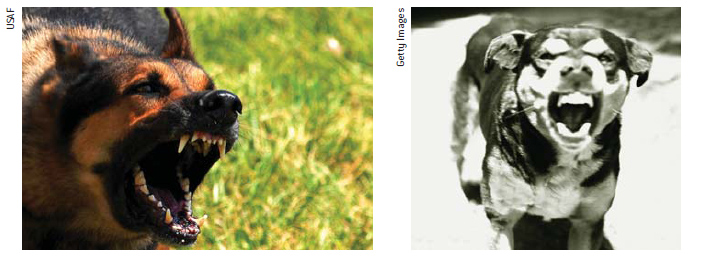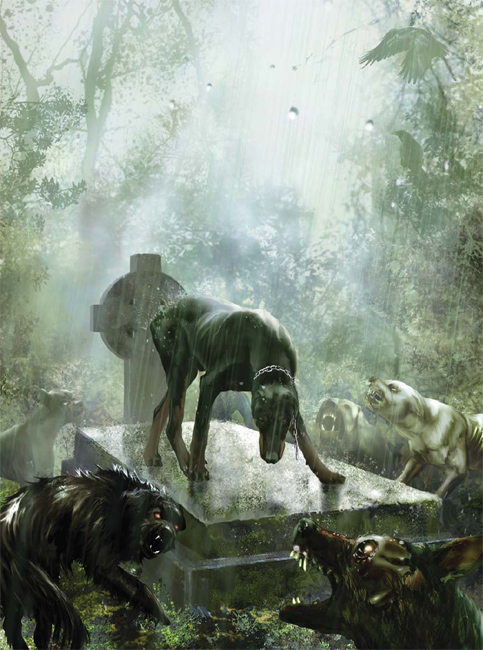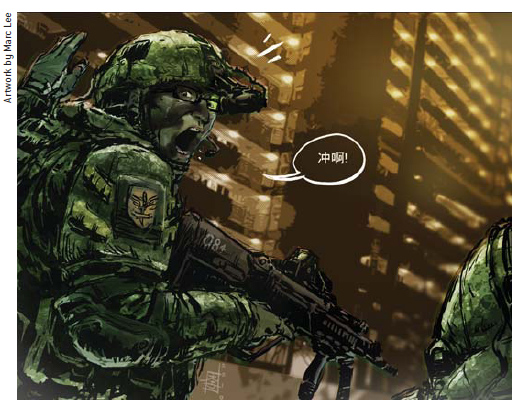Zombies (10 page)
Despite the huge number of zombie outbreaks in the US, Canada has been relatively untouched by the zombie menace. However in 2007, a small viral outbreak occurred in Toronto resulting in 132 deaths. During this incident, several witness identified a red-coated woman directing the zombies. Later identified as Katherine Flint, this mysterious individual appeared during two further zombie outbreaks in the United States, evading capture both times. She has quickly risen to near the top of the FBI's Most Wanted list, and remains the strongest evidence for a living zombie master.
Of course, this is all conjecture at this point, and I don't want to overstate the case. I do want to make it clear that the possibility of such zombie masters should be considered, and all zombie hunters should be on the lookout. Should a true zombie master ever be encountered in the field, all efforts should be directed at its immediate elimination. As much as science would relish the chance to study a live specimen, the danger of human intelligence guiding a zombie outbreak is too great a risk.
Â
15
From the unpublished diary of Joanna Blitch, which resides in the author's collection.
16
Never Again: An Outbreak Survivor's Tale
, Dark Asylum Press, 2004.
In 1982, Sgt E. Moore of the British 77th Division reported the existence of a pack of viral zombie hounds terrorizing villagers in the backwoods of Bulgaria. This report revived an old debate within the animate necrology community about the commonality and classification of zombified animals, a debate which continues to the present. While some scientists believe that a new branch of study should be opened to focus solely on undead animals, others, this author included, believe that animals should be viewed as members of one of the already existent zombie classifications. In nearly every case, zombie animals display the same strengths and weakness of a human corpse of the same zombie type. To lump all zombie animals into one category could cause confusion and do a major disservice to the men and women who risk their lives combating the zombie threat.


Two dogs infected with the Z-virus.
The story of zombie animals begins with the ancient necromancers. Theoretically, a sufficiently powerful necromancer can reanimate the body of any creature as a zombie. However, there seems little point in the exercise. Reanimated animals retain few of the advantages they possessed in life. Even the larger mammals become slow, weak creatures, neither significantly stronger nor tougher than a human zombie. True, necromantic fish can swim and some undead birds can fly, but it takes an extremely imaginative necromancer to make use of such ineffectual servants. For the most part, necromancers reanimate animals more for vanity than anything else. Perhaps a skeletal mastodon is a status symbol in the necromantic community. Some necromancers do use an undead animal as a sort of grim familiar, though to what end is unknown.
Interestingly, wielders of voodoo black magic are not able to create any zombie animals. Voodoo zombification requires the incarceration of the
zombi astral
, the soul of the deceased. Since animals do not possess souls, or at least not in the same way as humans, there is nothing for a bokor to imprison. Many bokors have other spells they use to enchant animals, but such magic is beyond this investigation.
The possibility of animal revenants remains an intriguing one, but there are no clear-cut cases to date. There are several reports of dogs that have exhibited signs of revenant behavior or appearance, but so far every case has ended with the destruction of the animal in question, so no true studies have been possible.
17
It was only with the dawn of the atomic zombie that animals became true participants in the zombie curse, and then only on a limited scale. As science is still trying to determine exactly how various chemical interactions lead to the reanimation of corpses, it cannot at this time say why certain species are vulnerable and others are not. In fact, it may be that a specific chemical reaction only causes the reanimation of certain species, and that we only tend to notice when that species is human or another large mammal. Luckily, atomic zombie animals mimic their human cousins and become slow, sluggish creatures.
18
Although dangerous, these undead animals have proven only a minimal threat to humanity, unlike their cousins, the viral hounds.

Unlike their human counterparts, zombie canines do possess a vague sense of hierarchy. Most zombie dog packs contain an alpha male, a dog that the others follow. These alpha males direct and guide their pack through a series of growls and barks that function in much the same way as zombie moaning.
While it has not been conclusively proven, zombie dogs show a predilection for attacking other dogs before attacking humans. Some mercenary containment unitsemploy their own (living) dogs to act as bait should they encounter a zombie dog pack.
There is perhaps a sick irony that the only species besides humans to be affected by the zombie viruses is man's best friend, but the truth is no joke.
19
As incredibly dangerous as viral zombies can be, they are nothing compared to the four-legged variety. Blessed with the natural speed and powerful jaws of many dog breeds, viral hounds strike like undead missiles, covering ground at an incredible rate and snapping at exposed flesh with infected teeth.
While neither viral zombies nor viral hounds employ true tactics, the two groups often unintentionally work together to trap living targets. The speed of the hounds means they always outpace human zombies, reaching the target first. These swift attackers invariably force the living to seek shelter in either a building or a vehicle. While this shelter does provide protection from the hounds, it leaves people vulnerable to the zombies following close behind who will likely batter their way inside.
Viral hounds can be eliminated through the destruction of the brain, but their speed and low profile make delivering such a blow difficult. Professional zombie hunters, when faced with a viral hound situation, almost always use vehicles in the first instance. Armored cars with battering rams or even snowplows make good weapons against viral hounds. Driving through a pack at high speed will usually mangle most of the hounds to such a degree that their speed advantage will be neutralized and they can be finished off at a leisurely pace.
Finally, a note on crows and other carrion fowl. It is not unusual to see birds pecking at the infected flesh of viral zombies (or any other type of zombie). While I can find no recorded case of birds becoming infected with the virus, eating zombie flesh has been known to cause aggressive, almost rabid behavior in birds â to the point that they will sometimes attack humans. These attacks are extremely dangerous as the birds strike from the sky and often go for a target's eyes. However, wounds caused in such an attack are not infected. To date, no one has ever received a zombie virus through a bird attack. Still, this is just one more reason why strong eye protection is necessary when fighting in an infection zone.
Â
17
The most famous case is the 1889 “Moor Hound Incident.”
18
For a full list of creatures reanimated through chemical means see Dr M. Ramalho's paper
The Unextinction Agenda
.
19
New research indicates that several primate species may also be vulnerable to the viruses.
Over the last two decades, the term “zombie hunter” has become diluted by the increasing number of amateur groups who seem determined to die in as gruesome a manner as possible. Theoretically, it is a problem that should take care of itself, but for every hick with a shotgun who gets his throat bitten out, it seems two more want to take his place. I have neither the time nor the inclination to talk about these groups. My interest is in the trained professionals who devote their lives to combating the zombie menace.
The first true zombie hunters probably date back to the days of prehistory, but aside from a few fables and legends, their stories have been lost to us. During the Crusades, several knightly orders formed for the express purpose of battling the undead, but if any true accounts of their activities survive, they are buried deep in the Vatican's
Corpus Mortuambulanticum
. In fact, despite the long history of zombies, the story of zombie hunting can only really be traced back to the mid-eighteenth century, with the formation of the Honourable Society of the Resurrection Men.
Generally, “Resurrection Men” refers to British body-snatchers of the eighteenth century, people who stole corpses and sold them to medical colleges. While technically illegal, the penalty for body-snatching was only a small fine, which was far outweighed by the potential profit. The trade became so popular, especially in Scotland, that it eventually attracted several necromancers who saw body-snatchers as easy supply men for zombie experiments. By the early 1750s, Edinburgh had become the necromantic capital of the world, and deaths due to zombie attack had reached unprecedented levels. While some body-snatchers grew wealthy supplying the necromancers, others turned against the trade. In 1756, an unknown Edinburgh body-snatcher founded the Honourable Society of the Resurrection Men in order to fight back. Because the society used an illegal practice to disguise their efforts to protect the public, the true identities of these first zombie hunters remain unknown. However, some of their
noms de plume
have become legendary: Mr Thomas Bones, Jonas Teeth Esq, Madame Noir Bent and
of course, Stanley Barrett, the cyclopean artist, whose disturbing one-eyed painting style has landed his works in museums throughout Europe and America.

For decades the society waged a vigilante war against the necromancers and their body-snatcher helpers. Both sides suffered numerous casualties, but while necromancer numbers slowly dwindled, the society grew, gaining members in high places. Eventually, the society won the war, not on the streets of Edinburgh, but in the Houses of Parliament. In 1832, Parliament passed the Anatomy Act, which changed the law regarding access to cadavers and effectively ended the body-snatching trade. Learning from this lesson, the society continued in its mission to stop necromancy but now used research and legal pressure as its main weapons. The Honourable Society of the Resurrection Men has survived to the present, and is now a pan-European organization dedicated to the elimination of all forms of zombie. However, as is wise for amateur organizations, they leave the actual combat to trained professionals.